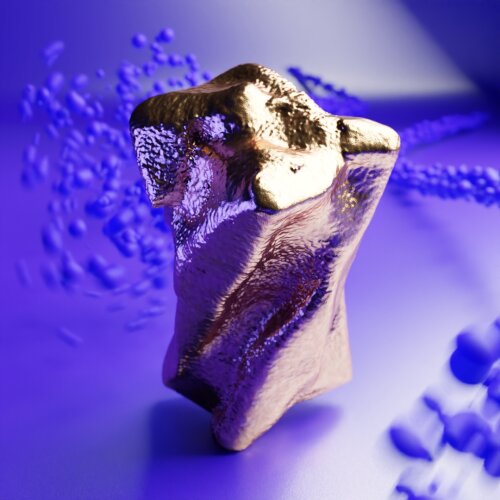
Challenge description
Chiral features in metal nanoparticles (NP) result in chiroptical properties, of interest to many applications, such as enantioselective catalysis or separation, chiral sensing or drug delivery. These applications arise from the different interactions of chiral plasmonic NPs with left- and right-handed circularly polarized light (CPL). Therefore, much effort has been put into the development of NPs with complex structures and morphologies. Multiple factors can be at the origin of the recorded CD signal, such as a helical morphology, chiral features in the crystalline structure, or the presence of chiral molecules at or near the surface of the chiral NPs. Unfortunately, there is no consensus on the relative importance of these different aspects. To obtain NPs with tailored chiroptical properties, it is thus important to understand the connection between the chiro-optical signal and the NP morphology.
Transmission electron microscopy (TEM) is an excellent technique to investigate the structure of nanomaterials. Several approaches, within the field of expertise of EMAT (Bals and Verbeeck), can be used to investigate the morphology, structure or properties of chiral nanoparticles. Examples include 3D structural characterization by scanning electron microscopy (SEM) or electron tomography in real and reciprocal space. Moreover, there is still debate in the field on the application of electron energy loss spectroscopy (EELS) to measure chiral features of nanoparticles. Although these techniques are already being developed at EMAT in the framework of other projects, their combined application to chiral nanoparticles will require further development. Moreover, quantification procedures, e.g. to define the degree of helicity will need to be developed. Such computational techniques, eventually based on the use of training a neural network as well as modeling of the connection between structure and properties are challenging aspects but the knowhow to help talented postdocs to overcome current limitations is available at EMAT (Bals, Lamoen, Verbeeck).
Recent papers with the participation of EMAT on the characterization of chiral nanomaterials:
- Chiral Seeded Growth of Au Nanorods into 4-Fold Twisted Nanoparticles with Plasmonic Optical Activity, Adv. Mater. 2023, 2208299
- Photothermal Circular Dichroism Measurements of Single Chiral Gold Nanoparticles Correlated with Electron Tomography, ACS Photonics 2022, in press
- Morphological and Optical Transitions during Micelle-Seeded Chiral Growth on Gold Nanorods, ACS Nano 2022, 16, 19281-19292
- Quantification of the Helical Morphology of Chiral Au Nanorods, ACS Materials Lett. 2022, 4, 642-649
- Micelle-Directed Chiral Seeded Growth on Anisotropic Gold Nanocrystals, Science 2020, 368, 1472-1477
- Demonstration of a 2 × 2 programmable phase plate for electrons, Ultramicroscopy 2018 190, 58
- Probing the symmetry of the potential of localized surface plasmon resonances with phase-shaped electron beams, Nature Communications 2017, 8, 14999
- Theory and applications of free-electron vortex states, Physics Reports 2017, 690, 1
- Extension of Friedel's law to vortex-beam diffraction, PRA 2016 94, 033858
- Prospects for versatile phase manipulation in the TEM: Beyond aberration correction, Ultramicroscopy 2015 151, 85
- Using electron vortex beams to determine chirality of crystals in transmission electron microscopy, PRB 2015, 91, 094112
- Orbital angular momentum in electron diffraction and its use to determine chiral crystal symmetries, PRB 2015, 92, 134108
- Is magnetic chiral dichroism feasible with electron vortices?, Ultramicroscopy 2014, 136, 81
What we offer
- We offer a preparatory mandate of at least 6 months (up to a maximum of 12 months) to initiate your research proposal and develop a competitive postdoctoral application on the topics related to characterization, modelling or applications of chiral nanomaterials.
- The candidate will be supported by EMAT in their postdoctoral application for the prestigious Flemish Science Foundation (FWO) or Horizon Europe Marie Curie fellowships.
- You will have the opportunity to be immersed in a world-class, dynamic and stimulating work environment with state-of-the-art instrumentation and computing facilities offered at EMAT.
- You will have the opportunity to collaborate with leaders in the field of chiral nanomaterials.
How to apply?
The candidate are required to submit the following: CV and motivation letter, SWOT analysis from the candidate, project proposal on the topic of chiral nanomaterials upon which to build an FWO or Marie Curie postdoctoral fellowships (max 2 pages), weblink to a short video introducing yourself and contact info of 2 professional referees
Detailed description of the job offer and application procedures can be found on the University of Antwerp vacancy page.
Evaluation procedures
Criteria for evaluation (pre-selection):
- Eligibility for FWO and MSCA postdoctoral applications with deadlines: FWO Dec. 2023/2024, MSCA Sept. 2023/2024 (go/no go)
- Project proposal: originality and impact (20%)
- Project proposal: methodology and feasibility (20%)
- Quality and impact of publication record and other scientific output (publications as first author, with citation impact and in prestigious journals, etc.) (15%)
- Scientific background and competences (relevant topic of research and acquired expertise in TEM methodology) (15%)
- Participation at conferences and workshops and research visits (invited talks, talk/poster prizes) (10%)
- Impact beyond publications (5%)
- Independence, leadership but also team-player (participation in larger networks) (5%)
- Participation in projects as co-PI (senior postdoc) (5%)
- Mentorship of students (senior postdoc) (5%)
Each pre-selection criteria will receive a score according to the FWO score grids for postdoctoral fellowships and the weights for each category are indicated in the list above. A ranking will be made according to the total score. The first 4 ranked candidates will be invited for an online interview in which all PIs will participate along with our research manager Lucian Covaci.
Criteria for evaluation at interview:
- Presentation of previous work: assess depth of knowledge on TEM concepts, communication skills, research attitude.
- Input on the current challenge: assess the level of understanding of the proposed topic and creative research proposal.